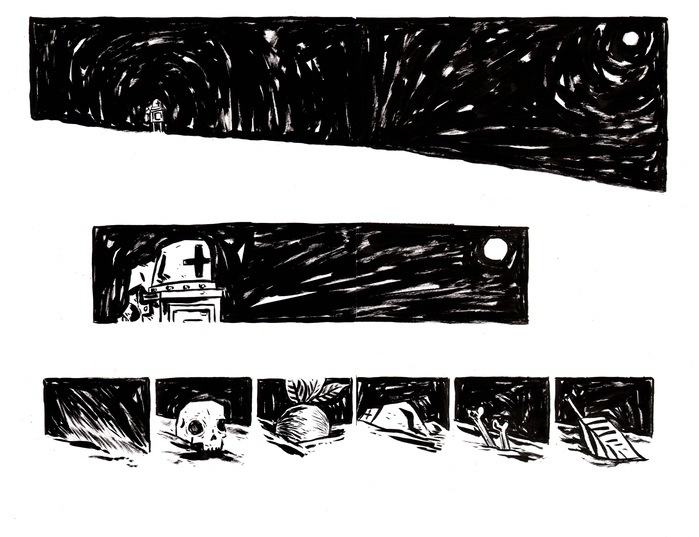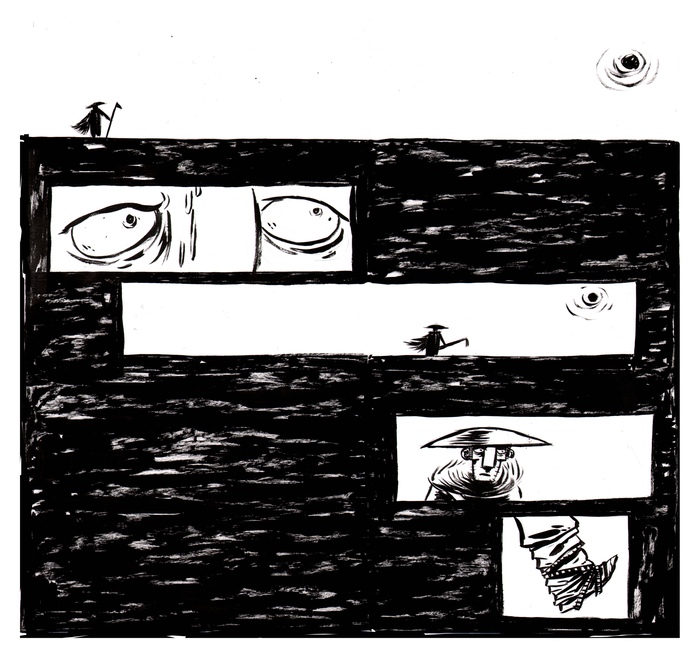There are a lot of indie creators out there under the radar paving out careers for themselves with fanbases, relatively small but extremely dedicated, that return again and again for new projects. One such creator is cartoonist Claire Connelly, who has been consistently delivering new content for the past several years, distributing it first through the web and later collecting it into print with Kickstarter. I spoke to her about her latest campaign for both The Long Year, a collection of short stories, and Black Eyes, a graphic novel.
What made you decide to Kickstart both Down With The Ship and Here in a single campaign in 2014?
I knew running a Kickstarter was going to be a lot of work, so I thought why not do two books at once? That way I can give people a better deal on the books themselves and the shipping. I just figured it would be more economical.
How do you think it’s more effective than doing two separate Kickstarters?
I make so many comics, so for me it just makes more sense to publish two books at a time. That way people can get a massive amount of comics all at once. Plus if I’m packing 100 envelopes it’s saves time packing two books at once versus packing one book at a time three months apart from each other.
How similar has your list of backers looked from one campaign to the next?
It looks similar but also has a lot of new faces. I would say at least half pledged to my previous Kickstarter.
How much of the list is made up with people you’ve personally interacted with?
I would say I’ve probably interacted with most of them. I’m really active on Twitter, so if people talk to me in general I’ll tweet back. Then others I’ve meet at cons or other comic events.
Are you able to support yourself entirely on your comics work?
I work on comics part-time and I’m a Barista part-time, but the plan is to be eventually drawing comics full-time. Coffee is cool, but comics are cooler.
Do you see yourself going on to work for established publishers, or do you always want the direct connection with your fans that social media and crowdfunding provides?
I would like to do a mixture of both. I think it’s fun to collaborate with publishers on projects and it’s fun to play in other people’s sandboxes. It’s nice from time to time to not have to do all the work myself. It takes a lot of time and effort to get a book completed by myself. I will always be making my own comics and publishing them either online or through crowdfunding. There’s an instant satisfaction in being able to completely 100% make what I want.
As a cartoonist, what do you look for in someone when they’re writing a script for you to draw?
When I get a script the most important quality I look for is that the story should be something I would never write. I want a story that doesn’t follow my own personal narratives that I write. Because if it’s something I could have written, then I might as well write it myself. When I work with Eric Grissom on Animals or Erica Schultz on Winston Churchill: The Unauthorized Biography, I want to be challenged and try something new. I also look for collaboration, I want to be part of the story process. It’s a little discouraging to have a script thrown at you and told to have it done in month.
What’s the appeal of doing short comics?
For me the appeal is being able to experiment. It’s hard to play with storytelling when it takes 8 months to complete a story. With a mini comic I can try out new ideas, layouts and designs that wouldn’t normally work in a longer narrative. I also using short comics as breaks from the longer works. Sometimes I just want to make a comic in a few days versus a story that takes a year. Making so many short comics has really helped me develop my own storytelling style and voice.
I’m also just a huge fan of short stories. I think in comics now there is so much emphasis on making 6 issue story arcs that can then be compiled into a trade. Comics no longer have those 64-page books full of 8-page stories about Dr. Strange and Nick Fury. I always thought those books were really interesting in how much story I got in eight pages.
So many of your comics are mostly silent. Does that signify a confidence in your storytelling skills as an illustrator, a lack of confidence with your skills as a writer, neither or both?
I have been drawing for as far back as I can remember, so I’ve always been really confident in my ability to draw. Also as far back as I can remember in school I was never really encouraged to write. I was always told I wasn’t goo enough and I have no grip of the english language. Because of that I was constantly discouraged and my grades reflected by poor writing skills. My arts teachers were always encouraging me from learning new instruments to letting me take art supplies. I’m actively trying to build my confidence in my writing and I trying to find my voice as a writer. I think because I never thought of myself as a writer, I find it a little intimidating. Because of that I’ve developed a style without much writing. I think it’s really important to be able to tell a story without words or to not have to story hinging on having words explain everything away. All my favorite cartoons like Samurai Jack or the beginning of Wall-E were all silent, and I couldn’t believe how much was being communicated to me without words. So I try to apply the same ideas to my comics.
What is the purpose of the dialogue and narration you when you do decide to include it?
When I use text in my comics it’s because the text is adding more content to the narrative. I think sometimes comics can get really text heavy, so I just use it when I feel it adds to the story. When I have stories with text, I work on the text and drawing together. I don’t draw out the story and just stick the text on top of it. I want the text and illustrations to grow together and compliment each other.
This time around some of the comics included in your books are colored. How did that change things?
When I started making comics I was trying to learn how to tell stories. So I really spent my time working in black and white to keep it simple and work on my inking. I like color because it builds narrative and sets the mood of the story. A yellow sun looks completely different then a black sun. Like when I write, I use color to add more content and tone to the story.
I don’t just color a comic because I feel I have too, I use color because I think it’s going to make the story stronger. Before I started making comics I did a lot of watercolor paintings, but like anything I had to find my voice with color. I had to stop having what I call “using all the crayons in the box syndrome” I need to learn some restraint.
You produce an astounding amount of content per year. What drives you to keep making more and more comics?
I really just want to keep getting better. It’s really that simple. I think the worst thing as an artist is when I feel stagnant and am not moving on to newer ideas, so I just keep on drawing. Plus, I mainly do all the work myself no one ever really tells me “no”. I try to work on my comics everyday. I have days that’s it’s tough to do so but I know if I want to accomplish all the goals I have in comics, I have to keep working. Comics are like training for a marathon. You have to do it every day. Now that I’ve been drawing comics everyday for the past three years, it’s just part of my everyday life.
Read most of Claire’s comic work for free on the web, support her Kickstarter campaign and follow her on Twitter and Tumblr.









Thank you for introducing me to her work!